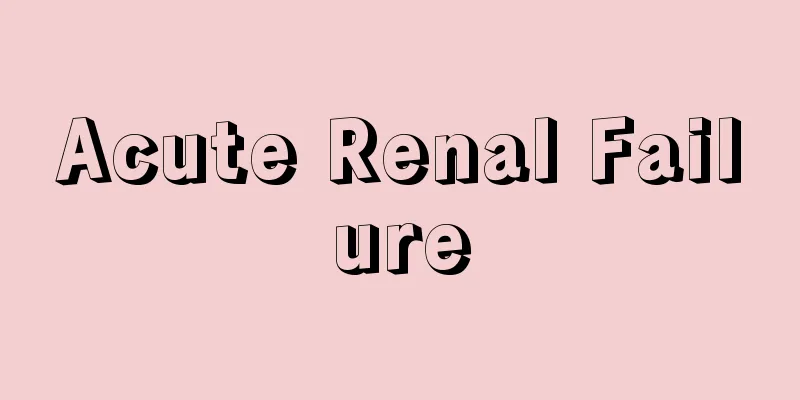Acute Renal Failure

|
[What kind of disease is it?] This is a condition in which waste products in the blood suddenly and relentlessly increase (azotemia). It is usually accompanied by oliguria, where the daily urine volume is 300-400 ml or less, or anuria, where the daily urine volume is 50-100 ml or less. There is also acute renal failure without a decrease in urine volume (non-oliguric). Acute kidney failure is classified into three types: prerenal, renal, and postrenal. Prerenal acute renal failure occurs due to a decrease in blood flow to the kidneys. Causes include hemorrhagic shock, dehydration, heart failure, and sepsis . Dehydration (heat stroke, diarrhea) in children and the elderly makes them more susceptible to acute renal failure. In addition, with large burns, a large amount of body fluids and electrolytes are lost, reducing blood flow to the kidneys and leading to acute renal failure. Renal acute renal failure occurs due to damage to the kidneys themselves. Kidneys are damaged by ischemia, toxins, substances in the urine (hemoglobinuria, myoglobinuria), acute nephritis, disseminated intravascular coagulation (DIC), obstruction of the renal artery and vein, inflammation of the renal tubules, and precipitation of calcium, uric acid salts, and abnormal proteins. Postrenal (obstructive) acute renal failure: Urine produced in the kidney passes through the renal pelvis, ureter, bladder, and urethra, but this is acute renal failure caused by an obstruction somewhere along the way that prevents urine from coming out of the urethra. Causes of obstruction include benign prostatic hyperplasia, prostate cancer, bladder cancer, pelvic malignant tumors, retroperitoneal tumors, and bilateral ureteral stones. [Symptoms] Symptoms vary depending on the degree of renal failure and the underlying disease. If oliguria or anuria is observed, acute renal failure or end-stage renal failure may be suspected. In particular, anuria may be caused by bilateral renal artery obstruction, postrenal acute renal failure, acute cortical necrosis, or rapidly progressive glomerulonephritis. In postrenal acute renal failure caused by obstruction of the prostate or urethra, a distended bladder can be palpated in the lower abdomen. Also, be aware that swelling (edema) is not seen in prerenal acute renal failure caused by dehydration. [Testing and diagnosis] A physical examination and ultrasound scan will be conducted to check for post-renal acute renal failure (urinary tract obstruction). Blood tests will show high values for urea nitrogen, creatinine, and potassium. Blood pressure will also be high. If potassium is too high, the heart will stop. In addition, fluid will accumulate in a chest X-ray, and the shadow of the heart will be large. If too much fluid accumulates in the chest, breathing will be impossible, which is very dangerous. [Treatment] The basis of treatment is to treat the underlying disease. However, high potassium levels and fluid accumulation in the chest must be improved immediately. In postrenal acute renal failure, depending on the site of obstruction, a catheter is inserted through the urethra or a catheter is inserted through the back into the kidney under ultrasound guidance to relieve the obstruction. In other cases of acute kidney failure, hemodialysis or peritoneal dialysis is performed to wait for the kidneys to recover. In acute kidney failure, water and salt intake is generally restricted. Source: Shogakukan Home Medical Library Information |
|
[どんな病気か] 血中の老廃物が急に絶え間なく増えていく状態(高窒素血症(こうちっそけっしょう))です。1日の尿量が300~400mℓ以下の乏尿(ぼうにょう)や、1日の尿量が50~100mℓ以下の無尿(むにょう)をともなうのがふつうです。尿量の減少をともなわない(非乏尿性)急性腎不全もあります。 急性腎不全は、腎前性(じんぜんせい)、腎性、腎後性(じんごせい)の3つに分類されます。 腎前性急性腎不全(じんぜんせいきゅうせいじんふぜん) 腎臓への血流の低下によっておこります。原因として、出血性ショック、脱水、心不全(しんふぜん)、敗血症(はいけつしょう)などがあります。子どもや老人の脱水(熱射病、下痢(げり))では急性腎不全がおこりやすくなります。また、大きな火傷(かしょう)(やけど)では、体液、電解質を大量に失い、腎臓への血流が減少して急性腎不全となります。 腎性急性腎不全(じんせいきゅうせいじんふぜん) 腎臓そのものの障害によりおこります。虚血、毒物、尿中物質(ヘモグロビン尿症、ミオグロビン尿症)、急性腎炎、播種性血管内凝固症候群(はしゅせいけっかんないぎょうこしょうこうぐん)(DIC)、腎動脈・静脈の閉塞(へいそく)、尿細管(にょうさいかん)の炎症、カルシウム・尿酸塩・異常たんぱくの沈殿などにより、腎臓が障害されておこります。 腎後性(じんごせい)(閉塞性(へいそくせい))急性腎不全(きゅうせいじんふぜん) 腎臓でつくられた尿は腎盂(じんう)・尿管(にょうかん)・膀胱(ぼうこう)・尿道(にょうどう)と通過しますが、その通り道のどこかが閉塞されて尿が尿道から出てこないことによる急性腎不全です。閉塞の原因は前立腺肥大症(ぜんりつせんひだいしょう)、前立腺がん、膀胱がん、骨盤内悪性腫瘍(こつばんないあくせいしゅよう)、後腹膜腫瘍(こうふくまくしゅよう)、両側尿管結石(りょうそくにょうかんけっせき)などがあります。 [症状] 症状は腎不全の程度、原因となった病気によって異なります。乏尿や無尿がみられたら、急性腎不全や末期腎不全が考えられます。とくに無尿の場合は、両側性腎動脈閉塞、腎後性急性腎不全、急性皮質壊死(えし)、急速進行性糸球体腎炎(しきゅうたいじんえん)などが考えられます。前立腺、尿道の閉塞による腎後性急性腎不全では、下腹部で拡張した膀胱を触れます。また、むくみ(浮腫(ふしゅ))は脱水により生じた腎前性急性腎不全ではみられないので注意が必要です。 [検査と診断] 診察、超音波検査により、腎後性急性腎不全(尿路閉塞)の有無をチェックします。血液検査では、尿素窒素、クレアチニン、カリウムの値が高く出ます。血圧も高くなります。カリウムが高すぎると心臓が止まってしまいます。また、胸のX線写真では水がたまり、心臓の影が大きく映ります。胸に水がたまりすぎると呼吸ができなくなり、たいへん危険です。 [治療] 治療の基本は原因となった病気の治療です。しかし、カリウムの高い状態や胸に水のたまった状態はすぐに改善しなければなりません。腎後性急性腎不全では、閉塞部位によって、尿道からカテーテルを入れたり、超音波を見ながら背中から腎臓へカテーテルを通して閉塞を解除します。 それ以外の急性腎不全では血液透析や腹膜透析(ふくまくとうせき)を行ない、腎臓が回復するのを待ちます。急性腎不全では、一般に水と塩分の摂取は制限されます。 出典 小学館家庭医学館について 情報 |
<<: Acute urticaria - urticaria
Recommend
College of Arms
… Family tree [Hideyuki Kato] 【Europe】 As seen in...
Wodonga (English spelling)
A city on the Murray River in northeastern Victori...
sambhoga-kāya (English spelling) sambhogakaya
...In Mahayana Buddhism, the thought of the Buddh...
Giant fruit fly - Giant fruit fly
...This is called the coffin fly, Conicera tibial...
Eptosomic type
…Since Hippocrates, there have been many studies ...
Wilkes, J.
…A radical political movement led by John Wilkes ...
Valence-sur-Rhône
The capital of the Drôme department in southeaster...
Snow Country
This is a medium-length novel by Kawabata Yasunar...
Ichiro Ichikawa
...In America, the National Association for the S...
Tuvalu (English spelling)
Located just south of the equator in the Southern...
Saganoseki Peninsula
A wedge-shaped peninsula in eastern Oita Prefectu...
Naosuke Ii
A senior councilor of the shogunate in the late E...
Twelve Ranks of the Crown
The first system of indicating the ranks within t...
Corporate control - Kigyoutousei
The term "state control" refers to the p...
Spheroidal (spherodized) pearlite
The correct term is spheroidal cementite structure...









